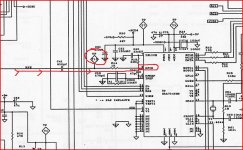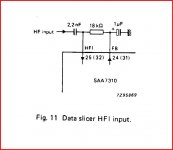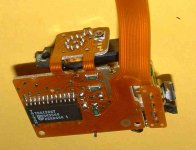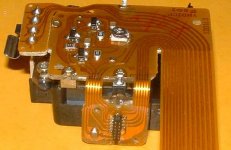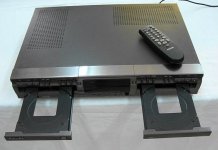Hey there guys. I just got an original Meridian 508 (18 bit) and I have a few concerns and questions. First of all, it sounds absolutely stunning. It is as close to the "liquid" sound of vinyl I have ever heard out of digital source, BUT it has a lot of difficulty reading CDs. It will only play a pristine CD and sometimes not even that. It will begin on the first track and after about 3-5 seconds, begins skipping through the tracks playing a few seconds of each.
Second, I listen to a lot of independent music that I download. I have always burned Audio CDs through iTunes and never had an issue playing them. Unfortunately the Meridian doesn't read them either and seems to treat them as I mentioned above. Do these players simply not read burned CDs?
I had some hope after reading some of the threads mentioning grease hardens on the mechanism and can cause skipping so I opened it up tonight and gave it a good alcohol swabbing. Unfortunately, this didn't have an effect and now I'm wondering if I need a new a new CDM 12.4. What do you think? If so, do you all know of a reliable source (meaning they aren't Chinese fakes)?
Second, I listen to a lot of independent music that I download. I have always burned Audio CDs through iTunes and never had an issue playing them. Unfortunately the Meridian doesn't read them either and seems to treat them as I mentioned above. Do these players simply not read burned CDs?
I had some hope after reading some of the threads mentioning grease hardens on the mechanism and can cause skipping so I opened it up tonight and gave it a good alcohol swabbing. Unfortunately, this didn't have an effect and now I'm wondering if I need a new a new CDM 12.4. What do you think? If so, do you all know of a reliable source (meaning they aren't Chinese fakes)?
I wrote this for a Micromega so just pick the bits relevant to the CDM12.4 itself,
This procedure applies to any player with the CDM12.4 or 12.1 pickup. Also make sure the lens is clean and if possible confirm the output with a scope.
"To repair properly (assuming this is the issue... it almost certainly is) involves unplugging the complete loader assembly and mech and laser and removing from the player. This allows you to work on it easily.
First eject the drawer normally, then pull the mains plug out. The drawer is fully removed by bending a plastic end stop out of the way and just pushing the drawer fully out... obvious when you look down at it. When you refit the drawer just push it back firmly. There are no timing problems etc or anything to align. When moving the drawer manually, always move it slowly because the loading motor acts as a generator when turned...
There is a clip on a plastic cover over a couple of gears at the front of the mech and a loading belt. These gears, or the spindles rather, is what cause the noisy drawer. Just remove the gears, clean them and the shafts and lubricate with the grease listed. Don't lubricate the teeth. The belt can be replaced too, round or square cross section it doesn't matter although square is best. These can be ordered in one offs from CPC etc, just measure the size.
The whole loader is secured by three screws under the player.
Also look where the flexi print runs from the laser to main board... make sure you see how it fits over the mouldings of the chassis.
The flexi print is released by pushing the "locking bar" on the socket forward. Thats two clips at each end... it doen't come off just moves forward a millimeter or so. That releases the foil. There is no high static risk with this pickup as it contains circuitry on board the laser.
The pickup... first draw where the six wires go (just in case) with their polarity (colours), two lots of two to the spindle motor and tiny sled motor and two to a micro switch. Carefully and quickly unsolder all. It can be better to snip them rather than linger with heat.
Now remove the pickup assembly. There are four neoprene supports. These are best removed from the pickup by using a small screwdriver to just push them to the outside of the pickup. There is a barb on the mech but it won't damage the support... just push them out.
You should have the laser mech on its own now. Be careful not to get grease etc on the lens, easy to do while handling.
The worm gear can be turned manually to move the pickup. You need to remove blue nylon gear and fully clean it in iso etc. Its held by clips so be carefull. Use card to clean all the teeth fully and the centre hole. Worth mentioning at this point that these can suffer with burrs... if so you have a problem, hopefully they are OK. Now clean the worm gear using card etc to get all the old grease out. The loading motor pops out, its held with a metal spring clip. Also clean the spindle shaft for the gear. Also try and clean the grease from the "toothed rack" on the laser itself. With the gear out the pickup is "free" to move. Clean the one rail and look at all the friction points as the pickup move.
Now reassemble using the grease shown. Lubricate the spindle of the nylon gear and the worm gear... just a smear on all the teeth.
Add some grease to all the friction points that the pickup moves on, the rail and plastic runners etc.
That should be it, reassemble the mech and resolder all the wires. Refit the flexiprint... hopefully all should be well. The front of the drawer, the metal trim, is held by sticky tape... unbelievable... and most are misaligned or creep. You can remove it, clean it and super glue it on the drawer. Make sure to get the three screws holding the loader correct as there is a bit of room for physical alignment. Then get the front plate correct.
The grease I use is this and its always performed faultlessly. The viscosity of the grease is important, too thick and it causes problems as a CD is read. The Stage players are unusual in that they read and store all track locations when a disc is inserted giving super rapid track access."
http://cpc.farnell.com/electrolube/spg35sl/special-plastics-grease-35ml/dp/SASPG35SL
This procedure applies to any player with the CDM12.4 or 12.1 pickup. Also make sure the lens is clean and if possible confirm the output with a scope.
"To repair properly (assuming this is the issue... it almost certainly is) involves unplugging the complete loader assembly and mech and laser and removing from the player. This allows you to work on it easily.
First eject the drawer normally, then pull the mains plug out. The drawer is fully removed by bending a plastic end stop out of the way and just pushing the drawer fully out... obvious when you look down at it. When you refit the drawer just push it back firmly. There are no timing problems etc or anything to align. When moving the drawer manually, always move it slowly because the loading motor acts as a generator when turned...
There is a clip on a plastic cover over a couple of gears at the front of the mech and a loading belt. These gears, or the spindles rather, is what cause the noisy drawer. Just remove the gears, clean them and the shafts and lubricate with the grease listed. Don't lubricate the teeth. The belt can be replaced too, round or square cross section it doesn't matter although square is best. These can be ordered in one offs from CPC etc, just measure the size.
The whole loader is secured by three screws under the player.
Also look where the flexi print runs from the laser to main board... make sure you see how it fits over the mouldings of the chassis.
The flexi print is released by pushing the "locking bar" on the socket forward. Thats two clips at each end... it doen't come off just moves forward a millimeter or so. That releases the foil. There is no high static risk with this pickup as it contains circuitry on board the laser.
The pickup... first draw where the six wires go (just in case) with their polarity (colours), two lots of two to the spindle motor and tiny sled motor and two to a micro switch. Carefully and quickly unsolder all. It can be better to snip them rather than linger with heat.
Now remove the pickup assembly. There are four neoprene supports. These are best removed from the pickup by using a small screwdriver to just push them to the outside of the pickup. There is a barb on the mech but it won't damage the support... just push them out.
You should have the laser mech on its own now. Be careful not to get grease etc on the lens, easy to do while handling.
The worm gear can be turned manually to move the pickup. You need to remove blue nylon gear and fully clean it in iso etc. Its held by clips so be carefull. Use card to clean all the teeth fully and the centre hole. Worth mentioning at this point that these can suffer with burrs... if so you have a problem, hopefully they are OK. Now clean the worm gear using card etc to get all the old grease out. The loading motor pops out, its held with a metal spring clip. Also clean the spindle shaft for the gear. Also try and clean the grease from the "toothed rack" on the laser itself. With the gear out the pickup is "free" to move. Clean the one rail and look at all the friction points as the pickup move.
Now reassemble using the grease shown. Lubricate the spindle of the nylon gear and the worm gear... just a smear on all the teeth.
Add some grease to all the friction points that the pickup moves on, the rail and plastic runners etc.
That should be it, reassemble the mech and resolder all the wires. Refit the flexiprint... hopefully all should be well. The front of the drawer, the metal trim, is held by sticky tape... unbelievable... and most are misaligned or creep. You can remove it, clean it and super glue it on the drawer. Make sure to get the three screws holding the loader correct as there is a bit of room for physical alignment. Then get the front plate correct.
The grease I use is this and its always performed faultlessly. The viscosity of the grease is important, too thick and it causes problems as a CD is read. The Stage players are unusual in that they read and store all track locations when a disc is inserted giving super rapid track access."
http://cpc.farnell.com/electrolube/spg35sl/special-plastics-grease-35ml/dp/SASPG35SL
Thanks Mooly. Great instructions but I did it already Cleaning the mechanism is time consuming, but easy enough to do so I might try again...I have a scope someone gave me but haven't gotten so deep into DIY as to learn how to use it. I've read up on the basics, but how would I use it to check output of the mechanism?
Cleaning the mechanism is time consuming, but easy enough to do so I might try again...I have a scope someone gave me but haven't gotten so deep into DIY as to learn how to use it. I've read up on the basics, but how would I use it to check output of the mechanism?
Another thing:
I'm playing an old Stones CD now that actually has a few scratches on it. It's tracking without a hitch! I tried some that are pristine and it tracks all over the place. What's up with that??? I'm thinking this may not be the laser mech since there is no consistent pattern here. Could this be something else entirely?
I'm playing an old Stones CD now that actually has a few scratches on it. It's tracking without a hitch! I tried some that are pristine and it tracks all over the place. What's up with that??? I'm thinking this may not be the laser mech since there is no consistent pattern here. Could this be something else entirely?
You would need to identify the "RF" test point to check with a scope. This will be one of the leads on the ribbon cable that goes to the pickup although it's easier to find a convenient point on the main PCB.
The RF signal should be around 1.2 to 1.5 volts pk/pk with a clear outline and no jitter. It's important to use the correct grounds for the scope to get a clean signal.
It should look at least as good as this and is the same for any disc,
NDP 4 Quality Assurance
If the disc runs true (no wobble at edge) then it is possible the pickup or spindle motor is faulty. A scope check is needed though to get an idea of what is happening.
The RF signal should be around 1.2 to 1.5 volts pk/pk with a clear outline and no jitter. It's important to use the correct grounds for the scope to get a clean signal.
It should look at least as good as this and is the same for any disc,
NDP 4 Quality Assurance
If the disc runs true (no wobble at edge) then it is possible the pickup or spindle motor is faulty. A scope check is needed though to get an idea of what is happening.
Mooly,
I think I have some time this evening so may open it up and try to figure it out (and clean it again). I know the ribbon cable you are talking about (it's orange). You will have to forgive my ignorance, but I don't see how I could play a disc with my scope in there testing that point. Do you have any idea where a good test point might be on the main PCB? Would I simply follow the trace to a point on the PCB?
FM
I think I have some time this evening so may open it up and try to figure it out (and clean it again). I know the ribbon cable you are talking about (it's orange). You will have to forgive my ignorance, but I don't see how I could play a disc with my scope in there testing that point. Do you have any idea where a good test point might be on the main PCB? Would I simply follow the trace to a point on the PCB?
FM
I think it's pin 4 on the flexiprint for the CDM12.4
If you can identify the chipset used then you can find the RF signal that way. If it's hard to get at then solder a small loop of wire onto the PCB (pin 4 of socket) to connect the scope too.
This was for the SAA7345 signal processor. The line marked in red goes to pin 4 of the CDM12.4 socket as best as I can make out.
If you can identify the chipset used then you can find the RF signal that way. If it's hard to get at then solder a small loop of wire onto the PCB (pin 4 of socket) to connect the scope too.
This was for the SAA7345 signal processor. The line marked in red goes to pin 4 of the CDM12.4 socket as best as I can make out.
Attachments
Mooly,
I put a scope on the Meridiant today and cleaned the transport again. The second cleaning uncovered a speck of hardened grease in the worm gear I had missed. This seemed to help it read discs that it wouldn't even begin to play, but still no recorded discs. It recognized how many tracks are on the disk, but skips through them all until it puts on the brakes and stops.
I really don't know a lot about what I'm doing with the scope, but voltage seemed to be around 1.3 which is within target. The wave did not look "clean" though. It looked a lot like a roller coaster with bumps. Jitter? The chip was actually SAA7310GP. I couldn't find a test point leading into it, but measured at the leg of the chip. I'm not sure if this affected results.
Thoughts?
FM
I put a scope on the Meridiant today and cleaned the transport again. The second cleaning uncovered a speck of hardened grease in the worm gear I had missed. This seemed to help it read discs that it wouldn't even begin to play, but still no recorded discs. It recognized how many tracks are on the disk, but skips through them all until it puts on the brakes and stops.
I really don't know a lot about what I'm doing with the scope, but voltage seemed to be around 1.3 which is within target. The wave did not look "clean" though. It looked a lot like a roller coaster with bumps. Jitter? The chip was actually SAA7310GP. I couldn't find a test point leading into it, but measured at the leg of the chip. I'm not sure if this affected results.
Thoughts?
FM
Grease is the big problem but if you have stripped and cleaned the gears and are sure all is well then the pickup has to be suspect.
When using the scope it is important to use the correct ground for these high frequency signals and also to use a proper probe, preferably a "divide by 10" as that raises the loading and reduces the capacitive load of the probe.
These are the pins for the SAA7310. It might be worth reading to the "left" on the 2.2nf cap. Use the same ground as the 1uf cap goes to. Note the absolute value of these parts may differ in your player but they will be present. The alternative pin numbers depend on the type of package, SMD or DIL
When using the scope it is important to use the correct ground for these high frequency signals and also to use a proper probe, preferably a "divide by 10" as that raises the loading and reduces the capacitive load of the probe.
These are the pins for the SAA7310. It might be worth reading to the "left" on the 2.2nf cap. Use the same ground as the 1uf cap goes to. Note the absolute value of these parts may differ in your player but they will be present. The alternative pin numbers depend on the type of package, SMD or DIL
Attachments
Mooly,
I put a scope on the Meridiant today and cleaned the transport again. The second cleaning uncovered a speck of hardened grease in the worm gear I had missed. This seemed to help it read discs that it wouldn't even begin to play, but still no recorded discs. It recognized how many tracks are on the disk, but skips through them all until it puts on the brakes and stops.
I really don't know a lot about what I'm doing with the scope, but voltage seemed to be around 1.3 which is within target. The wave did not look "clean" though. It looked a lot like a roller coaster with bumps. Jitter? The chip was actually SAA7310GP. I couldn't find a test point leading into it, but measured at the leg of the chip. I'm not sure if this affected results.
Thoughts?
FM
The actually question is, whether you have a genuine Sharp hologram laser diode inside or a bad clone from an unknown china manufacturer. In first case you will not observe any issues by replay of burned compact disc (only CDR, not CD-RW !!!).
check out this threads:
http://www.diyaudio.com/forums/digital-source/118902-stripdown-clean-cdm12-4-a.html
http://www.diyaudio.com/forums/digi...lt0h30pa-inside-philips-cdm12-vam12-mech.html
Try to find a CDM12.4 laserhead from NOS or a completly mechanism with genuine Philips sticker - this is the only possibility I know.
Thanks for the tips. After cleaning the mechanism twice with no improvement (and the skipping seems to get worse the more I listen), I ordered a mechanism with a Phillips laser from Stream Electronics via Amazon. They have good reviews that seem authentic so I'm hoping that does the trick. It cost about $26, and if it works, will be awesome and have saved me a sizable chunk of dough. I'll post back when it is installed.
Can't figure out where to address my question. I have a Micromega Stage 3, and as far as I understand many of these units have a common "skipping" problem. Anyone out there can help me solve this problem without having to go into the unit - -physically. I'm not a technician just an audiophile who really appreciates the merits of this unit. I have not found another unit that even comes close to being as musical as the Micro 3. Don't want to retire it, but on the other hand, the skipping" gets to be quite annoying after a while. Micromega is out of business, will not be responsible for defect(s)?
many thanks,
many thanks,
Can't figure out where to address my question. I have a Micromega Stage 3, and as far as I understand many of these units have a common "skipping" problem. Anyone out there can help me solve this problem without having to go into the unit - -physically. I'm not a technician just an audiophile who really appreciates the merits of this unit. I have not found another unit that even comes close to being as musical as the Micro 3. Don't want to retire it, but on the other hand, the skipping" gets to be quite annoying after a while. Micromega is out of business, will not be responsible for defect(s)?
many thanks,
A new thread maybe
Anyway, to fix this you have to strip it down (as in my post at the top). There are no special tools required, just time and care. Nothing can be done without taking the top off.
Bad news guys. I got the laser in about two days ago and installed but it won't play anything. It spins but doesn't pick up any tracks, only hits the brakes.  That's too bad. And irritating. The laser looked virtually identical to the original except the it did not have a 12.4 label. (I took that as a bad sign.) I don't know if it is the player or the laser. I'll switch it back out for the original tomorrow, but if it IS the player and not the laser, is there any other problem that might cause this skipping/not playing issue?
That's too bad. And irritating. The laser looked virtually identical to the original except the it did not have a 12.4 label. (I took that as a bad sign.) I don't know if it is the player or the laser. I'll switch it back out for the original tomorrow, but if it IS the player and not the laser, is there any other problem that might cause this skipping/not playing issue?
Just wondering, but the whole motor control might be responsible for issues since, even if the laser works, the disc must spin correctly. Any dried cap around?
HTH
I have thought of this but it will read certain CDs perfectly every time. Others it will not. I think if the motor control were bad, it would skip on every CD I played...But I could be wrong...I'm not sure what you mean by "dried cap." There is no dried grease, but I haven't checked for bad capacitors.
I suspect a bad new laser. Genuine Philips ones became generally unobtainable 10 yrs or so ago and many of the offerings are poor copies or "reclaimed" from old equipment and packaged up.
If the disc spins and seems to be at roughly the correct speed then out of interest I would scope the signal and see what is there but either way the CDM12.4 (given a good one) should work straight off.
If the disc spins and seems to be at roughly the correct speed then out of interest I would scope the signal and see what is there but either way the CDM12.4 (given a good one) should work straight off.
I have thought of this but it will read certain CDs perfectly every time. Others it will not. I think if the motor control were bad, it would skip on every CD I played...But I could be wrong...I'm not sure what you mean by "dried cap." There is no dried grease, but I haven't checked for bad capacitors.
Probably both you and Mooly are right. I'm a noob but I'm applying some simple tweak (bypass caps and so on) on my DVD player (a humble pioneer dv-300) and, looking at the schematics, I found a bunch of electrolytics in the motor control unit, so I simply inferred that aging caps might be a source of possible troubles.
Don't mean to b offensive, but I have to say that I solved skipping issues in three old players of mine, after several tries, by just applying lens cleaning liquid meant for glasses, instead of other products. But I bet you'll have surely did it!
Ciao,
Stefano
Which devices are on the foil PCB of your new optical pickup?Bad news guys. I got the laser in about two days ago and installed but it won't play anything. It spins but doesn't pick up any tracks, only hits the brakes.That's too bad. And irritating. The laser looked virtually identical to the original except the it did not have a 12.4 label. (I took that as a bad sign.) I don't know if it is the player or the laser. I'll switch it back out for the original tomorrow, but if it IS the player and not the laser, is there any other problem that might cause this skipping/not playing issue?
In those days there was only three kinds of foil PCBs:
1) with TDA1302T (i. e. integrated RF amp section and APC) mostly CDM12.4 - and VAM1205/VAM1252 with brushless disc motor (spindle motor)
2) discrete solution (discrete APC and without RF amp section)
3) with TZA1022TS (successor of TDA1302T, CDRW compatible - mostly used in VAM1250, not compatible to CDM12.4 head - check out picture number 7 by post #10 about
http://www.diyaudio.com/forums/digital-source/118902-stripdown-clean-cdm12-4-a.html
For your Meridian I think, the best solution is to order the VAM1252 head (professional version of CDM12.4) from the Marantz CD Player model CD7. Unfortunately the cost therefore is at least ten times higher, but you will get perfect NOS quality standart.
check out also this threads:
http://www.diyaudio.com/forums/digi...am1254-cdm12pro-vau1254-cdm12-4-compatib.html
http://www.diyaudio.com/forums/digital-source/165315-meridien-560-mod-mech-1205-cdm12-4-a.html
http://www.diyaudio.com/forums/digital-source/112650-vam-1205-vam1250-cdm12-5-a.html
http://www.diyaudio.com/forums/digital-source/77097-vam-1205-cdm-12-5-naim-cd5.html
P. S. A cost effectice burner/player, where the CDM12.4 is in use, is the model CDR765 from philips. For checking the RF signal and other measurement places is the service manual from this model helpful (check "hifi engine" or "hifi manuals").
Attachments
Last edited:
- Status
- This old topic is closed. If you want to reopen this topic, contact a moderator using the "Report Post" button.
- Home
- Source & Line
- Digital Source
- Original Meridian 508 skipping and disc reading problem
